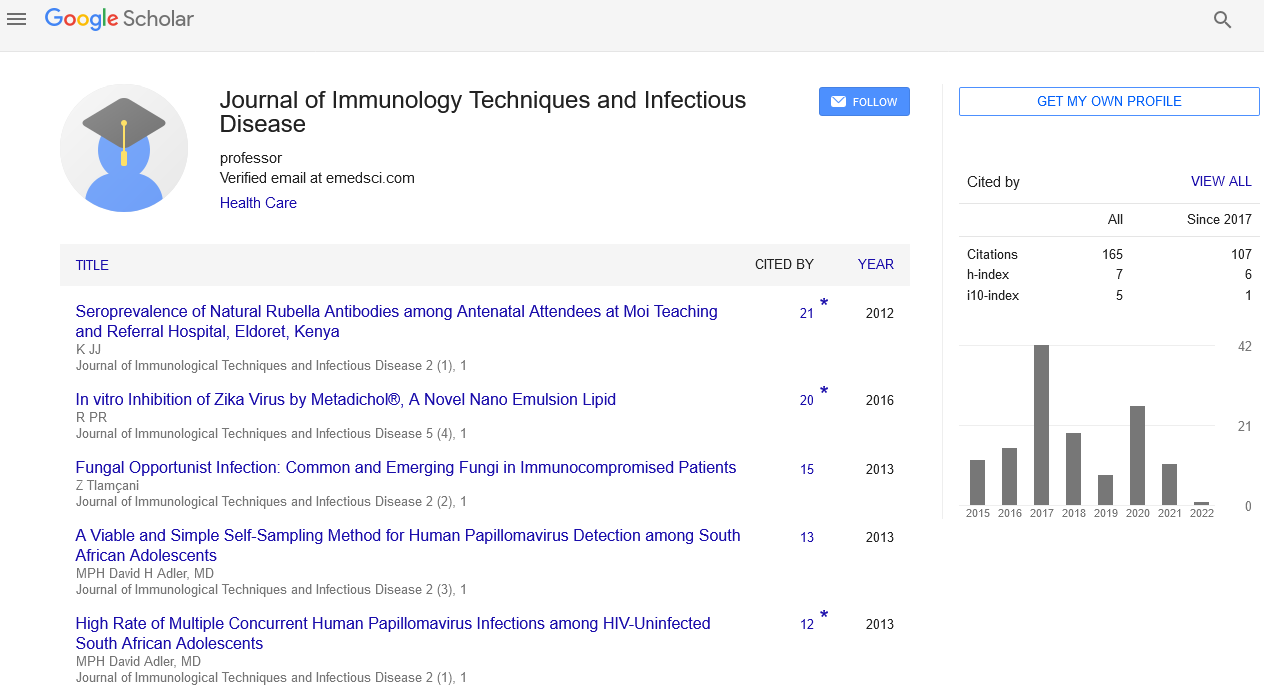Opinion Article, J Immunol Tech Infect Dis Vol: 13 Issue: 2
Science and Impact of Vaccination: An Important Assistance for Public Health
Damme Kirsten*
1Department of Vaccine, Medical University of Graz, Graz, Austria
*Corresponding Author: Damme Kirsten,
Department of Vaccine, Medical University
of Graz, Graz, Austria
E-mail: kirste.demm@gmail.com
Received date: 28 May, 2024, Manuscript No. JIDIT-24-145072;
Editor assigned date: 31 May, 2024, PreQC No. JIDIT-24-145072 (PQ);
Reviewed date: 14 June, 2024, QC No. JIDIT-24-145072;
Revised date: 21 June, 2024, Manuscript No. JIDIT-24-145072 (R);
Published date: 28 June, 2024, DOI: 10.4172/2329-9541.1000380.
Citation: Kirsten D (2024) Science and Impact of Vaccination: An Important Assistance for Public Health. J Immunol Tech Infect Dis 13:2.
Description
Vaccination has been one of the most significant medical advancements in human history, drastically reducing the prevalence of infectious diseases and protecting several lives. This preventive measure works by developing the immune system to recognize and combat pathogens without causing the diseases themselves.
Science of vaccination
Vaccination operates on the principle of immunological memory. The immune system has the outstanding abilities to remember previous discovers with pathogens and respond more effectively upon subsequent exposures. This memory is the foundation of how vaccines work. Vaccines typically contain inactivated, or parts of a pathogen (such as proteins or polysaccharides). When administered, these components stimulate the immune system to produce a response. This includes the production of antibodies and the activation of T cells, which can recognize and destroy the pathogen in future encounters. Because the vaccine contains non-infectious components, it does not cause the disease but prepares the immune system for potential future infections.
Types of vaccines
There are several types of vaccinations, each designed to stimulate a strong and effective immune response. Live attenuated vaccines contain live, but reduced, forms of the pathogen. Examples include the measles, mumps, and rubella vaccine and the varicella (chickenpox) vaccine. Inactivated vaccines contain pathogens that have been deactivated or eliminated. The Polio Vaccine (IPV) and hepatitis A vaccine are examples.
Subunit, recombinant, and conjugate vaccines use pieces of the pathogen (such as proteins) to stimulate an immune response. This section includes the hepatitis B vaccination and the Human Papillomavirus (HPV) vaccine. Messenger RNA (mRNA) vaccines use a piece of genetic material to instruct cells to produce a protein that triggers an immune response. Vector vaccines use a different virus to deliver genetic material from the pathogen to stimulate an immune response. Vaccine development and testing is a rigorous process involving multiple phases of study and testing. Preclinical study is before human testing, vaccines undergo laboratory and animal studies to evaluate safety and immunogenicity.
Clinical trials are conducted in three phases. Phase 1 involves a small group of volunteers to assess safety and dosage. Phase 2 expands to a larger group to further evaluate safety and immune response. Phase 3 involves thousands of participants to confirm efficacy and monitor for adverse effects. Regulatory agencies, such as the U.S. Food and Drug Administration (FDA) and the European Medicines Agency (EMA), analyze the trial data and approve vaccines that meet safety and efficacy standards. During post-marketing surveillance licensure, vaccinations are evaluated for long-term efficacy and typical adverse effects using systems such as the Vaccine Adverse Event Reporting System (VAERS).
Impact of vaccination
Vaccination has produced a significant influence on public health, resulting in the eradication, elimination, and management of several infectious illnesses.
Eradication and elimination: Smallpox is the only human disease to have been eradicated globally through vaccination, with the last natural case occurring in 1977. Polio is on the verge of eradication, with cases reduced by 99% since the late 1980s due to extensive vaccination efforts. Diseases such as measles and rubella have been eliminated in certain regions, though outbreaks can still occur if vaccination coverage drops.
Reduction of disease burden: Vaccination programs have significantly reduced the incidence of numerous diseases, including diphtheria, tetanus, pertussis (whooping cough), and Haemophilus Influenzae Type b (Hib). These reductions have not only saved lives but also decreased healthcare costs and improved quality of life.
Herd immunity: It is a condition that occurs when a significant portion of a population is vaccinated. This means that even those who cannot be vaccinated (due to medical reasons or age) are protected because the spread of the disease is minimized. Increase immunity is essential for protecting vulnerable groups such as infants, the elderly, and immuno compromised individuals.
Challenges and controversies
Despite the clear benefits, vaccination faces several challenges and controversies. Vaccine hesitancy, fueled by misinformation and distrust, provides a significant public health challenge. Concerns about vaccine safety, frequently based on misinformation, have led to decreased vaccination rates and subsequent outbreaks of preventable diseases. Public health campaigns and transparent communication are essential to combat misinformation and build optimism in vaccines. While vaccines are widely available in high-income countries, lowand middle-income countries frequently face barriers to access, including cost, distribution challenges, and healthcare infrastructure limitations. Global initiatives such as Gavi, the Vaccine Alliance, work to improve access to vaccines in these regions, but disparities remain.
Emerging infectious diseases of new infectious diseases, such as COVID-19, underscores the need for rapid vaccine development and distribution. The unprecedented speed of COVID-19 vaccine development demonstrated the potential for innovation, but it also highlighted challenges in manufacturing, distribution, and public acceptance. Antimicrobial resistance vaccines can play a significant role in combating antimicrobial resistance by preventing infections that might otherwise require antibiotic treatment. However, the overuse and misuse of antibiotics in conjunction with vaccination efforts need to be addressed to prevent resistance.
 Spanish
Spanish  Chinese
Chinese  Russian
Russian  German
German  French
French  Japanese
Japanese  Portuguese
Portuguese  Hindi
Hindi 
